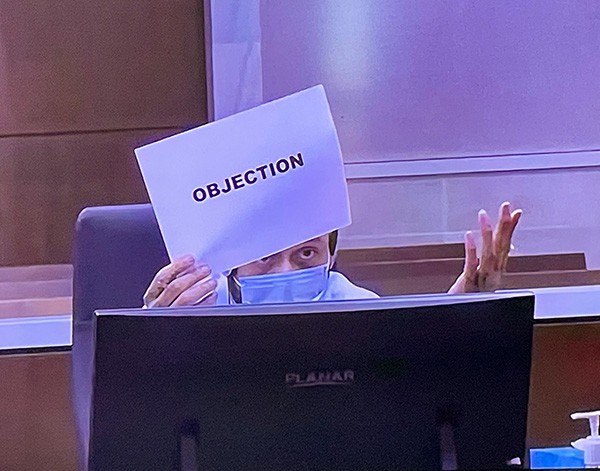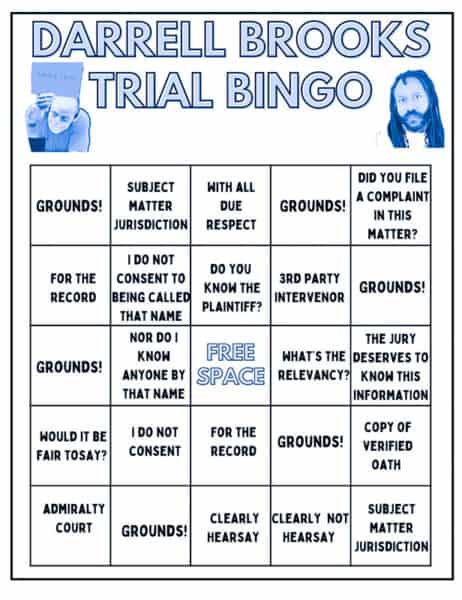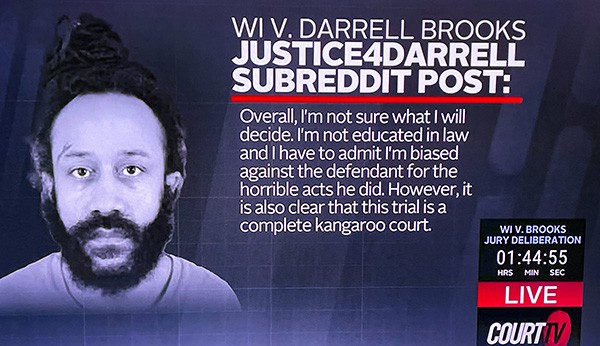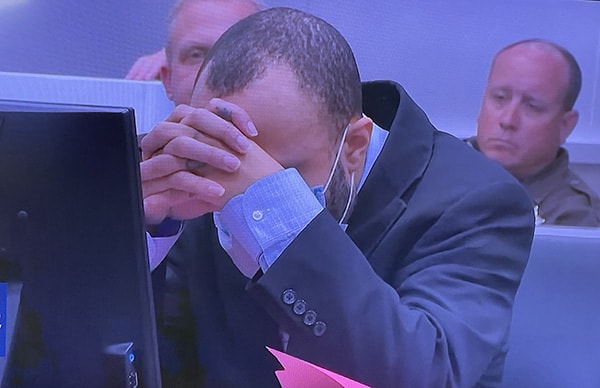Waukesha Christmas-Parade Trial, Closing Arguments and Verdict
- Post AuthorBy Anastasia Katz
- Post DateWed Oct 26 2022
Darrell Brooks was on trial in Waukesha for murder after he drove through the city’s Christmas parade, killing six people. On Monday, October 24, after Mr. Brooks had no more witnesses to call, Judge Jennifer Dorow asked if he was going to take the stand himself. He would not give her a straight answer. She tried to go through the standard yes-or-no questions about his right to testify, but he either said nothing, babbled about “subject matter jurisdiction,” or answered rudely.
Judge Dorow cited State vs. Anthony and Supreme Court case Rock v. Arkansas as precedents for a defendant forfeiting his right to testify in his own defense, based on bad behavior in court. She ruled that Darrell Brooks would not testify. “This court has tried to no avail to get him to answer simple questions,” the judge said. “This court can simply not allow Mr. Brooks to get on the witness stand.”
With no more witnesses for the defense, the judge declared the defense case rested. She dismissed the jury because she needed to discuss jury instructions with the lawyers. After interrupting the judge 27 times, Mr. Brooks was put in a different courtroom, where he had to participate remotely. He claimed he couldn’t hear the judge, but since they did manage to have some conversation, however unproductive, he could clearly hear her. The judge had a deputy, who had been in the second courtroom with Mr. Brooks, testify that the judge could be heard there. An IT tech verified that the sound system was working. Mr. Brooks claimed he has hearing loss.
As the judge continued the discussion about jury instructions, she muted Mr. Brooks’ microphone, but she said she could still hear him screaming from the next room. He piled discovery boxes in front of his face and asked to go back to his jail cell, but the judge said no. When the judge later had a question for Mr. Brooks, he did not respond, so she repeated her question until the defendant shouted, “I heard what the hell you said, man!” This video clip gives you a good idea of his demeanor.
This case has over 100 pages of jury instructions. When Mr. Brooks was given a copy, he put it in the trash, as you can see at the end of this this clip.
The next day, Tuesday, October 25, Judge Dorow had to put Mr. Brooks in the secondary courtroom again with his microphone muted so she could get through jury instructions. He tried to get her attention by waving his arms and his Bible.
Darrell Brooks raises an objection while muted.
Before closing arguments began, the judge warned Mr. Brooks that he could forfeit his right to give a closing argument if he broke the rules of conduct, or if he presented information that is not lawfully allowed in closing arguments. He was determined to bring up jury nullification, which is defined as “a jury’s knowing and deliberate rejection of the evidence or refusal to apply the law either because the jury wants to send a message about some social issue that is larger than the case itself, or because the result dictated by law is contrary to the jury’s sense of justice, morality, or fairness.”
Perhaps Mr. Brooks thinks he is at the center of a social justice issue. When the trial started, there was a little grumbling about the all-white jury, with Wisconsin lawyer Anthony Cotton saying, “It never feels fair when you’ve got an all-white jury judging a Black person.” However, no prominent black personalities have commented on this trial.
Judge Dorow tried to keep Mr. Brooks in the main courtroom for the prosecution’s closing, but he kept arguing with her in a way that she described as “stubbornly defiant,” so she sent him out again.
Each side was given one hour for closings. When the jury entered, Judge Dorow mentioned race for the first and only time in the entire trial. She read out instructions to the jury, telling them not to engage in implicit bias due to such things as race, religion, or national origin. She read these instructions with no fanfare and without comment of any kind from either Mr. Brooks or the prosecution.
DA Susan Opper summarized the 76 charges:
- Counts 1–6: 1st degree intentional homicide, while armed with a dangerous weapon
- Counts 7–67: 1st degree recklessly endangering safety, while armed with a dangerous weapon
- Counts 68–73: hit-and-run, causing death
- Counts 74 & 75: bail jumping
- Count 76: battery
She said Mr. Brooks was guilty of hit-and-run because he never stopped as he drove through the parade. He was guilty of bail jumping because he was out on bail on condition that he commit no further crimes. Battery referred to the injuries he inflicted on his girlfriend Erika Patterson: a split lip and a black eye.
The DA said that when considering the first-degree intentional homicide charge, the jury had to decide whether Darrell Brooks acted with intent to kill, and whether he was aware that his conduct was “practically certain to cause the death of another human being.” She referred to his six victims by name several times.
She explained that the Recklessly Endangering Safety charge does not require that anyone be injured, adding that Mr. Brooks recklessly endangered thousands of people when he drove through the parade. She showed the jury diagrams of the parade formations of the Waukesha South Band, the Xtreme Dance team, the Dancing Grannies, and Catholic Communities, labelled with the names of the injured and dead.
DA Opper said she didn’t have to prove what Darrell Brooks was thinking or why he acted. She had only to prove intent, and the proof of intent was that he could have just stopped driving. Mr. Brooks said throughout the trial that he had honked his horn. The DA said that goes both ways: “If he’s honking his horn, that means he can see something in front of him.” She also said that honking doesn’t give you the right to keep going if people in front of your car don’t move.
She mentioned the four police officers who testified that they tried to stop Mr. Brooks from entering the parade; he kept going. He could have stopped anywhere along the way, but instead he went on for four blocks at about 30 mph, plowing through 68 people. She asked, “How can you hit one and keep going?” She added, “He kept going until he got to the end and there were no more bodies to hit. It was intentional.”
The DA discussed how Mr. Brooks behaved after he drove through the parade, how he hid from police. She referred to the video the jury saw of the police interrogating Mr. Brooks. Never did he say it was all an accident.
DA Opper gave a chronology of events. First, she showed the jury a video from before the incident that showed marchers giving children candy to the tune of “Jingle Bell Rock.” Then she talked about what was happening at the same time: Darrell Brooks was arguing with Erika Patterson in his car, and driving the wrong way down a one-way street, “acting like it was everyone else’s fault.” She showed surveillance video of his red SUV parked before the hit-and-run, and Mr. Brooks getting into a shoving match with Miss Patterson’s friend Kori Runkel. The video shows him turn away and get into the driver’s seat.
“He’s enraged, he’s angry,” the DA said. She said that as Mr. Brooks passed the police officers who tried to stop him, his speed increased. He hit Nicole White; he ran into “and over the backs” of the high school band; he hit the Greene children, who were watching the parade. She described how he hit one victim after another, how he hit Jane Kulich “square on,” causing her to go up on the hood of the car, and then fall off, and he drove over her body. “He doesn’t stop! He keeps going!”
She talked about how he plowed through the Dancing Grannies, “striking most of them; injuring them; killing them.” He kept going through the Catholic Communities group, and DA Opper recalled witness Holly Berg, who said she saw “15 to 20 people flying in the air like bowling pins.”
She read the law on Intent: “The act need not be brooded over, considered, or reflected upon for a week, a day, an hour, or even for a minute. . . The intent to kill may be formed at any time before the act, including the instant before the act.”
The DA said she wasn’t telling the jury that Darrell Brooks set out that morning to kill people, “but when he became enraged, he didn’t give a damn who or what was in his way.”
She showed a photo of the damaged car, and talked about how the prosecution had the jury go look at it, to see the damage from hitting human bodies. People were knocked right out of their shoes. She showed photos of shoes strewn down Main Street, with scuff marks from the SUV’s tires.
She showed a picture of the children’s playhouse where Mr. Brooks hid his gray hooded sweatshirt to change his appearance, and video of him desperately asking people for a phone, while police sirens wailed in the back ground. She showed a chart of the path Mr. Brooks took after he abandoned the car. She mentioned that he made veiled threats as he approached people: “I won’t hurt you, but I need to use your phone.”
DA Opper said it was fortunate that Mr. Brooks took refuge in the home of Daniel Rider. Mr. Rider is the good-hearted white man who made Mr. Brooks a sandwich. She said this kept Mr. Brooks in one place as the police closed in.
The DA showed the jury the matching license plate numbers on a picture of Mr. Brooks driving through the parade, and a screenshot from his rap video. She held up the sweatshirt with Mr. Brooks’ DNA on it and showed photos of him wearing it as he drove through the parade.
Since Mr. Brooks had asked many witnesses if they noticed the tinted windows on his vehicle, the DA pointed out that his window was rolled down and it was clear that he was the driver.
She addressed his sovereign citizen argument, which led him to insist throughout the trial that he did not identify by the name Darrell Brooks, by showing a string of photos of him on the day of the incident, ending with his Wisconsin ID card. It clearly showed his name, “DARRELL EDWARD BROOKS JR.”
She said of the ID card: “In all capital letters, this was in his pocket when they arrested him.” This was a direct jab at the defendant. Members of the sovereign citizen movement reportedly believe they can avoid legal liability by not capitalizing their names, but this was his name, even in all uppercase. DA Opper also said his objections to being called by his own name were “shenanigans” and a “distraction.” Mr. Brooks objected: “What does she mean by shenanigans and this and that? . . . Can she tone that back?” Judge Dorow overruled.
“He drove right through them without a care in the world,” DA Opper said. “It’s time for Darrell Brooks to stop running. It’s time for him to stop lying. It’s time for him to be held accountable for his actions.”
She ended her closing with a long graphic video that was “stitched together” from many shorter ones, which showed him hitting every single victim with his SUV. At first there was silence as the video played; then people began to cry.
There was a break after the prosecution’s closing. With the jury still out, Darrell Brooks stalled, bringing up many of his kooky ideas. One joker who watched the trial compiled them into a “Darrell Brooks Trial Bingo” card.
When the jury came back, Judge Dorow told Mr. Brooks to begin, but he said, “I’m not ready to begin closing arguments.”
Judge Dorow started the one-hour timer anyway, and Mr. Brooks told the jury it had the power to nullify the law. She sent the jury out and cited laws to explain to Mr. Brooks why he is barred from talking about this. According to the law, the jury does not have the right to nullify. The judge told him it was time for his closing, and if he would not begin, he would forfeit his right to give one.
It was an empty threat, unlike the judge’s decision to prevent him from taking the stand. She let him keep arguing until DA Opper managed to suggest that they just let him talk, and the prosecution would make objections when necessary. The judge could give the jury instructions to disregard. “Or else,” DA Opper said, “we will continue at this pace forever.”
The jury was brought back, and Darrell Brooks finally gave his closing argument. He first suggested that there was information the jury had not been allowed to know. Then he described the district attorney’s closing as “rehearsed,” and called the State’s exhibits “theatrics.” He, by contrast, was “speaking from the heart.”
When he said, “You have the power to nullify any law that you don’t agree with,” the prosecution objected and the judge told the jury to disregard the statement.
Mr. Brooks repeated what he said in his opening: He wouldn’t argue fact; the incident was “tragic.” As he did in his opening, he said he was feeling “emotional,” then paused, and took a deep breath. He looked like he was trying to summon tears, but when he couldn’t, he said he didn’t “have any tears left.”
He told the jury he felt powerless that other people “ran with the narrative” and “painted a picture” that had “zero truth.”
He said, “With every healing process, comes a forgiving process.” He said that anyone who really knew him would not think this was an intentional act.
He said there had been a recall on the vehicle used in the incident, and the prosecution objected because he had never provided evidence of that. Mr. Brooks asked, “What if the driver was unable to stop the vehicle because of the malfunction and panicked?”
He claimed there could not have been an intent to kill because no one was injured on the first two blocks into the parade route, and because he honked the horn.
He was insulted that the DA described him as having been in a rage — “How can you have the audacity to diagnose where someone’s brain is?”
Although the prosecutor said he had acted with “disregard for human life,” he said he had children he had watched come into this world, that he cut their umbilical cords, and held them before their mothers did. He said his children couldn’t go to school because of the lies that were told about him. He said his mother had to stay at a hotel because of the hate mail she received. He feared for his nieces’ and nephews’ safety.
He said it was hard to answer his eight-year-old daughter’s questions. He got a letter from her in which she wrote, “Dad, why are all these people saying all these mean things about you?” He said it was hard to think about his younger children getting older and having to explain everything to them. He complained that he had not been able to hold, touch, or kiss his newborn son.
He made himself the victim: “No one’s heart is more in pieces than mine.”
He talked about how he prayed in his cell, asking, “How could this happen?” He said he believed in Jesus Christ, and tried to “acknowledge him” every day. He brought his Bible to court because that was how he lived his life. Mr. Brooks said no one would ever know “why it was His will for this to happen.”
He asked the jurors to open their hearts, but he also seemed to threaten them: “I pray the right decision is made. The right decision.”
Almost comically, he warned them: “Don’t let this decision weigh on you when it’s over. . . . Don’t look back and kick yourself in the behind.”
He said it took “courage and guts” for the jury to put their lives on hold while they served, and he thanked them for setting a month aside. He said they deserved “a round of applause.”
He ended with, “You guys know what’s right. Thank you.”
The district attorney was allowed a rebuttal, and Susan Opper used it to say that while Mr. Brooks talked about the fact that he never held his newborn son, never once did he acknowledge the families of those he killed. “It’s nice Mr. Brooks can get letters from his loved ones,” she said.
She said actions define a person. It didn’t matter if he stood with a Bible in his hands all day long. He had driven over children playing musical instruments as his vehicle heaved up and down. Jackson Sparks flew off the front of his car, lifeless, and Mr. Brooks kept going. Jane Kulich flew off the hood of his car, and he kept going. “You need to look in the mirror, Mr. Brooks,” she said, “Your actions are those of a murderer. You murdered these six people. You endangered the safety of 61 others. There are 68 victims in this case. That’s not an accident.”
Judge Dorow excused the jury so it could begin deliberations. Mr. Brooks then asked if he could go to the jail to take a shower; he claimed inmates get only two showers a week. The judge said that if the jury had questions, he would need to be back in court, properly dressed. The judge told Mr. Brooks she might order that he be allowed to shower that night or the next morning.
The judge then said that at 9:10 a.m. that morning, she learned there was a post on Reddit, in a Subreddit called “Justice for Darrell,” from an anonymous person who claimed to be a juror on the case. The judge said the post was being investigated by a forensic unit. She did not think there was “credible information” that it was from a jury member.
“What is this?” asked Mr. Brooks.
The anonymous poster wrote that he believed Mr. Brooks committed the crime, but he thought Judge Dorow was biased against him. The poster thought Mr. Brooks had not been given a chance to plead his case; he had been “silenced and mocked at almost every turn.” The poster said he had become convinced that subject matter jurisdiction was “a great concern,” and had learned of jury nullification. The supposed juror wrote, “This trial is a complete kangaroo court,” and said he was torn between locking Mr. Brooks up and throwing away the key, and jury nullification.
Mr. Brooks could have written the post. He was allowed internet access while acting in his own defense. However, after Judge Dorow put the police on the case, the person who made the post admitted he is not a juror.
The jury was given pizza for dinner while it deliberated. Jurors asked to see the video of the Dancing Grannies being hit, in slow motion. They also asked to see the picture of girlfriend Erika Patterson with bruises on her face, the map of the parade route, and the video of the confrontation between Mr. Brooks, Miss Patterson, and her friends. The jurors were allowed to stay as long as they wanted, but after deliberating for an hour and a half, they went to the hotel where they are sequestered.
The judge announced that court would resume at 8:30 the next morning. Mr. Brooks smiled and said, “I’m not getting up that early.” I suspect the jurors were too tired to fill out all the paperwork.
Today, Darrell Brooks was present in the courtroom. The jury entered and read the verdict: guilty on all counts. At the second count of “guilty” of first-degree homicide, a man in the gallery shouted, “Burn in hell, you piece of shit!”
Darrell Brooks reacts to the verdict.
There have been people in the gallery during the entire 23-day trial. This was the first outburst, and the judge ordered the man removed from the courtroom. I’m sure that many feel just as he did.
There will be a sentencing hearing on Monday.
Editor’s Note: An earlier version of this article mischaracterized one of the alleged beliefs of the Sovereign Citizen Movement.
- Post TagsBlack on White Crime, Crime, Murder



